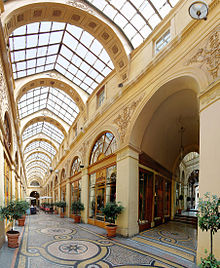
Back Winkelsentrum Afrikaans Centro comercial AN مركز تسوق Arabic Centru comercial AST Ticarət mərkəzi Azerbaijani Гандлёвы цэнтр Byelorussian Търговски център Bulgarian বিপণি কেন্দ্র Bengali/Bangla Centre comercial Catalan ᏧᏔᎾ ᏚᎾᏓᎾᏅ CHR


A shopping center (American English), shopping centre (Commonwealth English), also called a shopping complex, shopping arcade, shopping plaza or galleria, is a group of shops built together, sometimes under one roof.[3]
The first known collections of retailers under one roof are public markets, dating back to ancient times, and Middle Eastern covered markets, bazaars and souqs. In Paris, about 150 covered passages were built between the late 18th century and 1850, and a wealth of shopping arcades were built across Europe in the 19th century. In the United States, the widespread use of the automobile in the 1920s led to the first shopping centers of a few dozen shops that included parking for cars. Starting in 1946, larger, open air centers anchored by department stores were built (sometimes as a collection of adjacent retail properties with different owners), then enclosed shopping malls starting with Victor Gruen's Southdale Center near Minneapolis in 1956.
A shopping mall is a type of shopping center, a North American term originally meaning a pedestrian promenade with shops along it, but in the late 1960s began to be used as a generic term for large shopping centers anchored by department stores, especially enclosed centers.[4][5][page needed] Many malls in the United States are currently in severe decline ("dead malls") or have closed. Successful exceptions have added entertainment and experiential features,[6] added big-box stores as anchor tenants, or are specialized formats: power centers, lifestyle centers, factory outlet centers, and festival marketplaces.[7] Smaller types of shopping centers in North America include neighborhood shopping centers, and even smaller, strip malls. Pedestrian malls (shopping streets) in the United States have been less common and less successful than in Europe.[4][5][page needed] In Canada, underground passages in Montreal and Toronto link large adjacent downtown retail spaces.
In the United Kingdom and Europe shopping malls/centers continue to grow and thrive.[8] In the region distinction is made between shopping centers (shops under one roof), shopping precincts (pedestrianized zones of a town or city where many retail stores are located),[9] the "high street" (street – pedestrianized or not – with a high concentration of retail shops),[10] and retail parks (usually out of the city center, 5000 sq.m. or larger and anchored by big-box stores or supermarkets, rather than department stores).[11]
- ^ "Canadian Shopping Centre Study" (PDF). Retail Council of Canada. December 2016. Retrieved January 18, 2017.
- ^ Gössel, Peter; Leuthäuser, Gabriele (2022). Architecture in the 20th Century. TASCHEN. p. 22. ISBN 978-3-8365-7090-9.
- ^ "Shopping centre", Oxford Learners Dictionary
- ^ a b Howard, Vicki (2008). The Routledge Companion to the History of Retailing. Taylor & Francis. ISBN 978-1-138-67508-7.
- ^ a b Longstreth, Richard (2010). The American Department Store Transformed, 1920–1960. Yale University Press. ISBN 9780300149388.
- ^ Petro, Greg (April 5, 2019). "Shopping Malls Aren't Dying – They're Evolving". Forbes.
- ^ Cite error: The named reference
ICSC definitionswas invoked but never defined (see the help page). - ^ "Research: Shopping Centres Continue To Dominate European Retail Space, But Significant Variations Exist Between Countries". European Council of Shopping Places. April 11, 2023.
- ^ "Shopping precinct", Cambridge Dictionaries
- ^ "High street", Oxford Dictionaries
- ^ Cite error: The named reference
cushmanwas invoked but never defined (see the help page).
© MMXXIII Rich X Search. We shall prevail. All rights reserved. Rich X Search